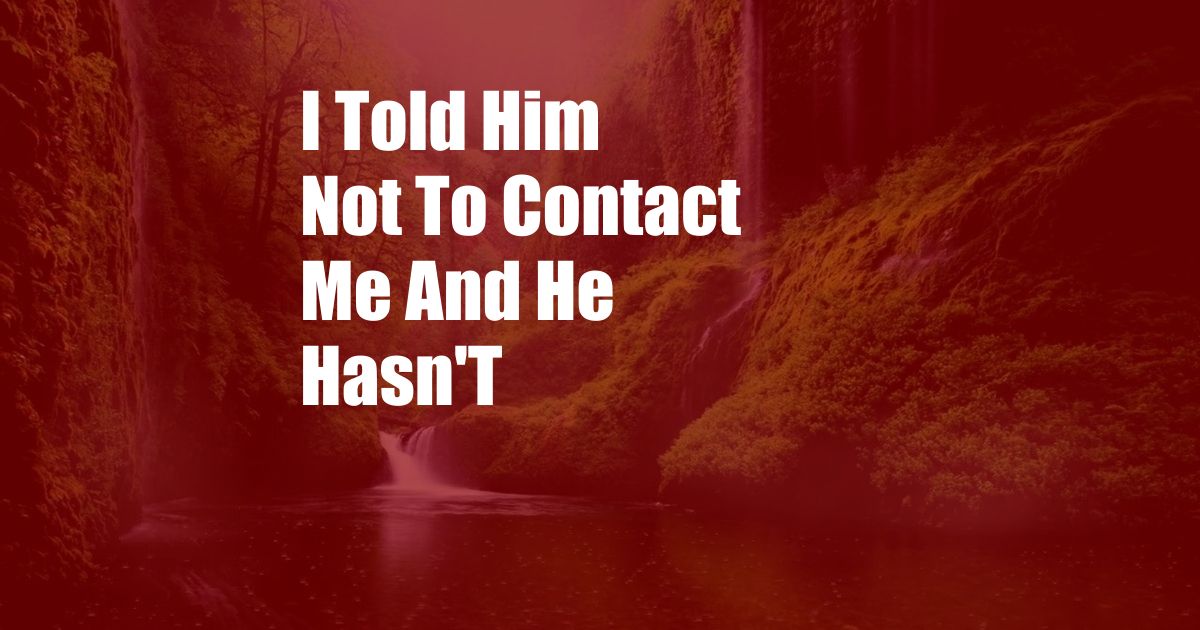
I Told Him Not to Contact Me and He Hasn’t: Breaking Down No Contact
In the realm of relationships, there comes a time when boundaries must be set and maintained. The decision to implement a “no contact” rule can be a difficult one, often stemming from the need to preserve emotional well-being and create space for healing. Yet, the aftermath of declaring such boundaries can be equally unsettling, leaving one grappling with a myriad of emotions, including anxiety, confusion, and a sense of uncertainty. If you find yourself in a situation where you’ve instructed someone not to contact you, and they’ve complied, it’s natural to experience a range of feelings.
You may be surprised, relieved, or even a bit disappointed. The absence of their presence can be jarring, especially if you were accustomed to regular communication. Alternatively, their compliance may reinforce your belief that the decision was the right one, providing a sense of confirmation and empowerment. Whatever your reaction, it’s important to understand the significance of “no contact,” its potential implications, and how to navigate this challenging period.
The Psychology of “No Contact”
The “no contact” rule is a form of self-protection that involves cutting off all forms of communication with another individual. It’s often employed as a means to heal from a relationship that has ended, whether it be romantic, familial, or platonic. By creating a physical and emotional distance, the person initiating “no contact” aims to regain control over their own life and emotions, while simultaneously sending a clear message that their boundaries are not to be violated.
The Benefits and Challenges of No Contact
Implementing “no contact” can bring about several benefits. It provides a much-needed space for introspection and emotional healing, allowing individuals to process their thoughts and feelings without external distractions or influences. By removing the temptation to engage in communication, “no contact” can help break unhealthy patterns and promote personal growth.
However, it’s important to acknowledge that “no contact” is not without its challenges. The initial phase can be particularly difficult as individuals may experience intense emotions and withdrawal symptoms. There may be a longing for the other person’s presence, a desire for closure, or even guilt and feelings of loneliness. It’s crucial to remember that these emotions are a natural part of the healing process and will gradually subside with time and self-care.
Expert Tips for Navigating No Contact
Embracing the “no contact” rule requires resilience and a commitment to personal well-being. Here are some expert tips to help navigate this challenging period:
- Set Clear Boundaries: Communicate your “no contact” request clearly and directly. Let the other person know that you need space and that you will not respond to any attempts to initiate contact.
- Block Communication: To ensure that your boundaries are respected, consider blocking the person on all forms of communication, including phone, text, email, and social media.
- Focus on Self-Care: Dedicate this time to prioritize your own physical, mental, and emotional well-being. Engage in activities that bring you joy and fulfillment, and seek support from trusted friends, family, or a therapist.
- Maintain a Positive Mindset: It’s important to approach “no contact” with a positive outlook. View it as an opportunity for personal growth and healing, rather than a punishment.
- Seek Professional Help: If you find yourself struggling to cope with the emotions associated with “no contact,” do not hesitate to seek professional help from a therapist or counselor. They can provide objective support and guidance.
Frequently Asked Questions (FAQs)
- How long should I maintain “no contact”? The duration of “no contact” varies depending on individual circumstances and the nature of the relationship. There is no set rule, but experts recommend a minimum of 30 days to give yourself ample time to heal.
- What if the other person reaches out? If the other person attempts to contact you during the “no contact” period, it’s important to remain firm and reiterate your boundaries. Do not respond or engage in any form of communication.
- Can I break “no contact” early? Breaking “no contact” early can hinder your healing process and send mixed signals to the other person. If you feel the need to break “no contact,” proceed with caution and consider seeking professional guidance.
- What if I regret implementing “no contact”? If you have second thoughts about “no contact,” it’s important to evaluate your reasons for implementing it in the first place. If the situation has changed significantly or you feel ready for reconciliation, you may consider reaching out to the other person.
Conclusion
Implementing the “no contact” rule is a powerful tool for self-protection and healing. By understanding the psychology behind “no contact,” adhering to expert advice, and seeking support when needed, you can navigate this challenging period and emerge stronger and more resilient. Remember, the decision to maintain “no contact” is not a sign of weakness but rather a testament to your strength and determination to prioritize your well-being.
If you are currently navigating the complexities of “no contact,” know that you are not alone. With patience, self-care, and a strong support system, you can overcome this challenge and create a more fulfilling life for yourself.